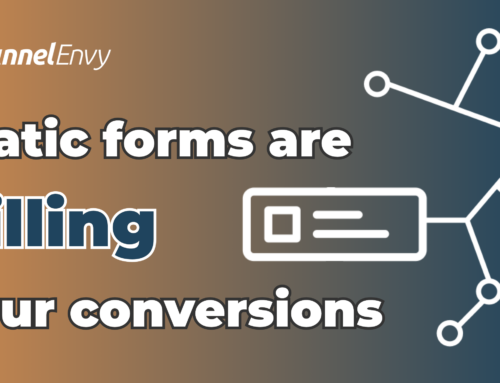To achieve success in modern digital B2B marketing, the alignment of marketing and sales teams is no longer optional—it’s a necessity. Misalignment between these critical functions can result in wasted resources, poor lead quality, and missed revenue opportunities.
Despite the clear benefits, achieving harmony between marketing and sales remains challenging for many B2B organizations. This disconnect can stem from siloed teams, unclear roles, and conflicting priorities.
This post will guide you through what marketing and sales alignment is, why it’s essential for B2B success, and practical steps to foster collaboration for limited ROI.
What is B2B Marketing and Sales Alignment?
Marketing and sales alignment, sometimes amusingly called “smarketing,” refers to unifying the goals, tools, and strategies of” these two “departments to deliver a seamless buyer experience and maximize revenue.
When aligned, these teams work as a single unit to identify, nurture, and convert leads, significantly improving pipeline efficiency and overall performance.
Why is Marketing and Sales Alignment Crucial for B2B Conversions?
Marketing and sales alignment is the foundation for successful B2B lead generation and conversion. Without it, businesses risk losing valuable prospects due to disjointed messaging, inconsistent processes, or a lack of understanding between teams.
The benefits of alignment extend beyond just better communication—they directly impact conversion rates and revenue in a couple of critical ways:
Improved Lead Quality: Marketing can focus on generating leads that meet sales criteria, reducing wasted time on unqualified prospects.
Higher Conversion Rates: Aligned teams work together to nurture leads effectively, resulting in smoother transitions through the sales funnel.
Enhanced Customer Experience: A unified strategy ensures consistent messaging, making the buyer journey seamless and engaging.
Common Challenges in Achieving Alignment
Achieving alignment between marketing and sales is crucial for improving conversions, but it’s often easier said than done. The following challenges may prevent organizations from fully optimizing their lead generation and conversion efforts:
Miscommunication and Siloed Departments
One of the most significant obstacles to alignment is miscommunication between the marketing and sales teams. These teams often operate in silos, with limited cross-departmental interaction. As a result, each team may develop its own approach, strategies, and language.
- Different Tools and Processes: Marketing teams may use automation tools and content management systems that sales teams aren’t familiar with, while sales might rely on CRMs and lead-tracking tools that marketing has little insight into.
- Lack of Knowledge Sharing: When marketing and sales aren’t actively collaborating, valuable insights from one department may not reach the other. Marketing might create content based on industry trends and buyer personas that sales teams don’t utilize. On the other hand, sales teams can miss out on understanding the leads’ needs and pain points that marketing uncovers through their research and content engagement.
- Inefficient Handoff Process: The disconnect can lead to bottlenecks where leads are poorly handed off between marketing and sales. Sales may struggle to engage with leads who aren’t yet sales-ready, or they may waste time on unqualified prospects, which reduces conversion efficiency.
This breakdown in communication ultimately results in lost opportunities and frustration for both teams. Regular, structured meetings and shared platforms help bridge the gap and enable more effective collaboration.
Differing Goals and Metrics
Marketing and sales teams typically operate with different sets of priorities, and this divergence can create friction.
- Marketing’s Focus on Lead Volume: Management may measure the marketing department’s performance based on the number of leads it generates. This is an important metric, but it doesn’t always reflect the quality of those leads. Marketing teams may focus on casting a wide net, aiming for high lead volumes without taking into account how these leads align with the sales team’s target audience.
- Sales’ Focus on Conversions: On the other hand, sales teams care most about converting leads into customers. They are typically judged on deal closures and revenue generation. If they are handed leads that aren’t well-qualified, the conversion process becomes inefficient, frustrating both the sales team and potential customers.
The solution is to set common goals aligning both teams’ efforts, such as joint KPIs that track conversion rates from lead generation to deal closure.
Inconsistent Messaging
When sales and marketing are not aligned, messaging can become fragmented, confusing prospects and weakening the brand’s overall message.
- Inconsistent Content and Communication: Marketing may produce content such as blog posts, landing pages, or email campaigns with a particular message or tone, but if sales teams aren’t aware of these resources or aren’t using them consistently, the message can become inconsistent.
- Brand Disconnect: In the worst-case scenario, these inconsistencies may cause a breakdown in the buyer’s trust in the company’s brand. If a prospect receives conflicting messages or feels like the sales approach doesn’t align with their previous interactions, they may lose confidence in the business altogether.
To avoid this, marketing and sales must agree on the core messaging and value propositions that should be communicated at every stage of the buyer journey.
Taking Steps to Achieve Marketing and Sales Alignment
Overcoming challenges requires a structured approach that fosters collaboration and ensures that both teams work toward shared goals. Here are vital steps to align marketing and sales for better B2B conversions:
Create a Unified Buyer Persona
Start with a shared understanding of your ideal customer. Both teams should contribute insights to develop comprehensive buyer personas, including demographics, pain points, and decision-making factors.
Set Common Goals and Metrics
Define success metrics that both teams can rally behind. For example, instead of measuring marketing by lead volume alone, focus on metrics like marketing-qualified leads (MQLs) that convert into sales-qualified leads (SQLs).
Develop a Lead Scoring System
Agree on what constitutes a qualified lead and implement a lead-scoring system to prioritize prospects. Integrated marketing automation tools with your CRM can help assign scores based on criteria like engagement, company size, or budget, ensuring sales focus on the most promising opportunities.
Align Messaging and Content
Ensure consistency in messaging across all stages of the buyer journey. Marketing should equip sales with content tailored to different touchpoints, such as case studies for prospects in the consideration stage or ROI calculators for those closer to making a decision.
Streamline Internal Processes
Leverage tools that bridge the gap between marketing and sales. CRMs, marketing automation platforms, and collaboration tools like Slack or Asana can facilitate information sharing and keep teams aligned. A funnel audit can help identify the best tools and processes for seamless collaboration.
Regular Communication and Collaboration
Schedule recurring meetings between marketing and sales to review performance, discuss challenges, and refine strategies. Incorporate feedback loops to ensure continuous improvement and adaptability to changing market dynamics.
Measuring the Success of Marketing and Sales Alignment
How do you know if your efforts to align marketing and sales are paying off? Tracking the right metrics is crucial. Here are the key metrics to monitor:
Lead Conversion Rates: Measure the percentage of MQLs that become SQLs and eventually close as customers.
Customer Acquisition Cost (CAC): Assess how alignment impacts the efficiency of your customer acquisition efforts.
Sales Cycle Length: A shorter sales cycle often indicates better collaboration and lead nurturing.
Revenue Growth: The ultimate goal—alignment should contribute to measurable increases in revenue.
FunnelEnvy’s analytics tools can help you track your results, providing actionable insights into the performance of your marketing and sales alignment initiatives.
Moving Ahead to Align B2B Marketing and Sales
Marketing and sales alignment is essential for B2B organizations looking to boost conversions, streamline processes, and drive revenue growth. Achieving alignment may seem daunting, but it’s a journey worth taking. With a structured approach and the right support, your teams can work together to achieve remarkable results.
Are you struggling to align your marketing and sales teams? FunnelEnvy’s Full Funnel Conversion Audit is designed to identify gaps in your strategy and provide actionable insights to improve alignment and maximize ROI. Schedule your audit today and start turning your leads into revenue.







